Stimulasi Kreativitas Gerak Anak Melalui Senam Si Buyung
DOI:
https://doi.org/10.46963/mash.v3i02.159Keywords:
Si Buyung’s Gymnastic, Creative MovementAbstract
In general, gymnastics is only imitation of movement from beginning to end but in this study gymnastics is combined with stories that are imagined by children, which are then realized into motion with the aim of stimulating the creativity of early childhood movements. In this research si buyung’s gymnastic modified to be warming up, creative movements, and cooling down. The research was quantitative quasi-experimental method with one group time-series design on 52 children aged 4-5 years in Yogyakarta. Data collection used interviews and observations, then analyzed with Kruskal Wallis. The results showed that implemented si buyung’s gymnastic effectively to increase the movement creativity of children aged 4-5 years is evidenced by the acquisition of asymp.sig p-value. 0,000 <0.05 which means there is a significant difference in the average ranking of children's creativity in each treatment.
Downloads
References
Eriani, E., & Dimyati. (2019). Fantasy Gymnastic as an Active and Imaginative Learning Model to Children ’ s Gross Motor. Atlantis Press, 296(Icsie 2018), 408–411. https://doi.org/10.2991/icsie-18.2019.76
Gallahue, D. L., & Ozmun, J. C. (2010). Understanding Motor Development. New York: McGraw-Hill.
Ghiffar, M. A. N., Nurisma, E., Kurniasih, C., & Bhakti, C. P. (2018). Model Pembelajaran Berbasis Blended Learning Dalam Meningkatkan Critical Thinking Skills Untuk Menghadapi Era Revolusi Industri 4.0. Prosiding Seminar Nasional Pendidikan.
Hun, R., & Cheung, P. (2010). Early Child Development and Care Designing movement activities to develop children's creativity in early childhood education. Early Child Development and Care, 180(3), 37–41. https://doi.org/10.1080/03004430801931196
Juniasih, I. (2015). Peningkatan Kreativitas Gerak melalui Kegiatan Tari Pendikan Berbasis Cerita (Tarita). Jurnal Pendidikan Anak Usia Dini, 9(2), 319-342. https://doi.org/10.21009/JPUD.092.08
Kaufmann, A. K., & Ellis, B. J. (2010). Preparing Pre-Service Generalist Teachers to Use Creative Movement in K-6. ournal of Dance Education, 7(1), 7–13.
Kustati, Hartiwan, U., & Supriyono. (2016). Peningkatan Hasil Belajar Senam Ritmik Si Buyung Menggunakan Lagu Potong Bebek Angsa. Journal of Physical Education, Health and Sport, 3(40), 32–42.
Lum, C. (2017). Research in Dance Education Musings about creative movement : coming to terms with music , movement and drama. Research in Dance Education, 7893, 1–12. https://doi.org/10.1080/14647893.2017.1420766
Mawarti, S., Sukamti, E. R., Supriyanto, A., Nurhandaru, H., Widanita, N., & Kinasih, A. (2011). Pelatihan Senam Si Buyung Lewat Gerak dan Lagu untuk Guru TK Se-DIY. Yogyakarta: Universitas Negeri Yogyakarta.
Mayesky, M. (2006). Creative Activities For Young Children (8th ed). Australia: Thomson Learning.
Munandar, U. (2012). Pengembangan Kreativitas Anak Berbakat. Jakarta: Rineka Cipta.
Nainggolan, O. T. P. (2018). Peranan Metode Eurhythmics Terhadap Peningkatan Kreativitas Gerak. Resital: Jurnal Seni Pertunjukan, 16(3), 117–124. https://doi.org/10.24821/resital.v16i3.1677
Petersen, D., & Ã, D. P. (2012). Suggestions for enhancing assessment of creative movement Space, Time, Weight, and volume. Physical Education and Sport Pedagogy, 13(2), 37–41. https://doi.org/10.1080/17408980701444726
Picard, C. (2015). Creative Movement and Transformation to Choreography : A Mode of Research Presentation. Nursing Science Quarterly, 21(2), 112–114. https://doi.org/10.1177/0894318408315012
Pradipta, G. D. (2013). Strategi Peningkatan Keterampilan Gerak Untuk Anak Usia Dini. Jurnal Jendela Olahraga, 2(1), 140-147.
Rachmawati, Y., & Kurnati, E. (2010). Strategi Mengembangkan Kreativitas pada Anak Usia Dini. Jakarta: Kencana Prenada Media Guru.
Rahmawati, R., & Simatupang, N. D. (2014). Senam si buyung dengan metode demonstrasi dalam pengembangan motorik kasar anak. Obsesi, 1(2), 1–6.
Steele, J. S., Fulton, L., Nbct, L. F., Steele, J. S., Fulton, L., & Fanning, L. (2017). Dancing with STEAM : Creative Movement Generates Electricity for Young Learners. Journal of Dance Education, 16(3), 112–117. https://doi.org/10.1080/15290824.2016.1175570
Sugiyono. (2016). Metode Penelitian Kuantitatif, Kualitatif, dan R&D. Bandung: Alfabeta.
Sumantri, S. M., Yunengsih, E., & Hasanudin. (2017). Efektivitas Strategi Pembelajaran dan Pengalaman Gerak Terhadap Kreativitas Gerak Siswa Kelas Dasar. Jurnal Pendidikan Anak Usia Dini, 11(1), 49–66. https://doi.org/10.21009/JPUD.111.04
Taylor, I. S., Morris, V. G., Meredith, C. D., & Hicks, C. (2012). Music and Movement for Young Children ’ s Healthy Development. Dimensions of Early Childhood, 40(2), 33–40.
Theodorakou, K., Zervas, Y., & Method, M. T. (2010). The Effects of the Creative Movement Teaching Method and the Traditional Teaching Method on Elementary School Children’s. Sport, Education and Society, 8(1), 91–104. https://doi.org/10.1080/1357332032000050088
Downloads
Published
How to Cite
Issue
Section
License
Authors who publish with this journal agree to the following terms:
1. Copyright on any article is retained by the author(s).
2. The author grants the journal, right of first publication with the work simultaneously licensed under a Creative Commons Attribution shareAlike 4.0 International License that allows others to share the work with an acknowledgment of the work’s authorship and initial publication in this journal.
3. Authors are able to enter into separate, additional contractual arrangements for the non-exclusive distribution of the journal’s published version of the work (e.g., post it to an institutional repository or publish it in a book), with an acknowledgment of its initial publication in this journal.
4. Authors are permitted and encouraged to post their work online (e.g., in institutional repositories or on their website) prior to and during the submission process, as it can lead to productive exchanges, as well as earlier and greater citation of published work.
5. The article and any associated published material is distributed under the Creative Commons Attribution-ShareAlike 4.0 International License







2.png)



